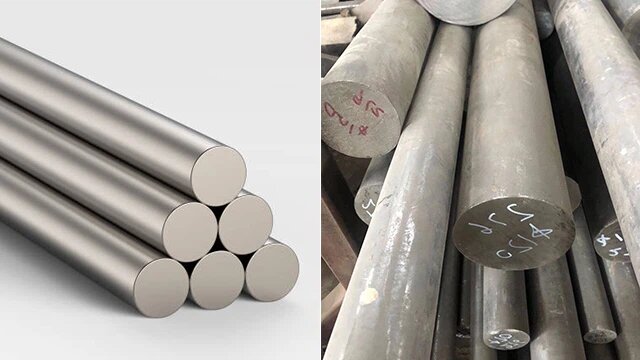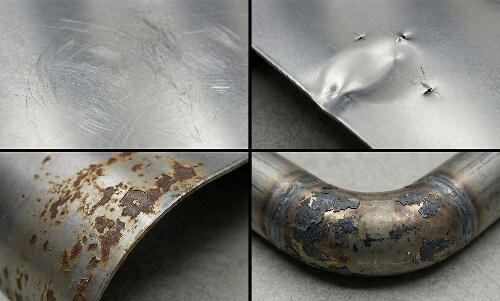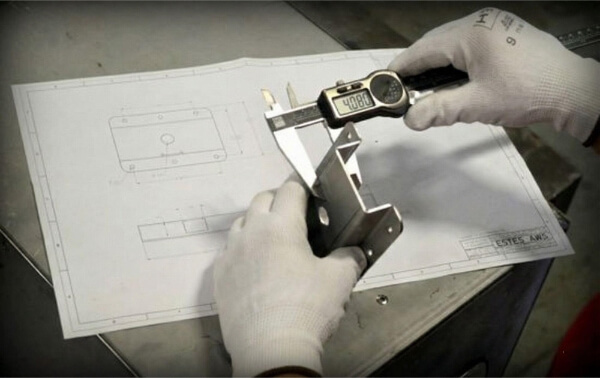A seleção do metal tem impacto na durabilidade, custo e desempenho do produto. Os engenheiros enfrentam frequentemente desafios quando decidem entre ligas e aço inoxidável para os seus projectos. A má escolha do material aumenta os custos de manutenção, a falha prematura de peças e os atrasos no projeto. A escolha correta do aço optimiza o desempenho e o orçamento.
Tanto o aço-liga como o aço inoxidável têm finalidades distintas no fabrico. As ligas de aço combinam ferro com crómio, níquel e molibdénio para aumentar a resistência e a dureza. O aço inoxidável contém pelo menos 10,5% de crómio, criando uma camada protetora de óxido que evita a corrosão. Cada tipo destaca-se em aplicações específicas.
As diferenças entre estes metais vão para além da composição básica. Vamos examinar as suas propriedades únicas, aplicações e considerações de custo para o ajudar a decidir sobre o seu próximo projeto.

Definição de ligas de aço
A espinha dorsal do fabrico moderno, o aço de liga representa uma mistura precisa de ferro, carbono e elementos adicionais concebidos para atingir caraterísticas de desempenho específicas.
Composição e caraterísticas
As ligas de aço resultam da mistura de ferro com carbono e outros elementos. O teor de carbono varia normalmente entre 0,3% e 1,7%. A adição de manganês, crómio e níquel transforma o aço normal num metal mais forte e mais adaptável. O tratamento térmico melhora ainda mais estas propriedades, tornando o aço mais duro e mais durável.
Ligas comuns utilizadas
- Aço crómio-molibdénio (4130): Oferece uma excelente resistência e tenacidade
- Aço de níquel-crómio (4340): Oferece resistência ao desgaste e força superiores
- Aço manganês Cria um material duro e resistente ao trabalho
- Aço silício: Melhora as propriedades magnéticas e a resistência eléctrica
Vantagens da liga de aço em relação ao aço inoxidável
- Custo-efetividade: Custos de produção mais baixos devido ao menor número de elementos de liga
- Maior relação resistência/peso: Melhor desempenho em aplicações estruturais
- Maquinação mais fácil: Requer ferramentas e processamento menos especializados
- Melhor capacidade de tratamento térmico: Mais reativo aos processos de endurecimento
Definição de aço inoxidável
Um grupo especializado de ligas de aço que combina força com uma excecional resistência à corrosão através da adição de elementos específicos, principalmente crómio.
Composição e caraterísticas
O aço inoxidável destaca-se pelo seu teor mínimo de crómio de 10,5%. Este crómio cria uma camada de óxido invisível na superfície. Quando riscada, esta camada reforma-se automaticamente na presença de oxigénio. O material também contém quantidades variáveis de níquel, molibdénio e outros elementos para melhorar propriedades específicas.
Tipos de aço inoxidável
- Austenítico (série 300): Mais comum, contém 16-26% de crómio e 6-12% de níquel
- Martensítico (série 400): Maior teor de carbono, magnético e tratável termicamente
- Ferrítico (série 400): Contém apenas crómio, magnético mas não tratável termicamente
- Duplex: Combina estruturas austeníticas e ferríticas para uma maior resistência
Vantagens do aço inoxidável em relação ao aço de liga
- Resistência superior à corrosão: Resiste à ferrugem e à oxidação
- Propriedades de auto-regeneração: A camada de óxido reforma-se quando danificada
- Excelente higiene: Fácil de limpar e higienizar
- Melhor resistência química: Lida com ambientes agressivos

Liga de aço vs aço inoxidável: Comparação de propriedades
Uma análise detalhada das propriedades físicas e mecânicas revela o desempenho de cada tipo de aço em condições reais. Segue-se um estudo comparativo do seu desempenho.
Força e durabilidade
O aço ligado demonstra uma resistência à tração superior, atingindo frequentemente valores 50% mais elevados do que os tipos de aço inoxidável comparáveis. O aço-liga 4340 tratado termicamente atinge resistências à tração superiores a 280.000 PSI, enquanto a maioria dos aços inoxidáveis atinge um máximo de cerca de 200.000 PSI. O aço ligado também mantém uma melhor resistência ao desgaste sob cargas pesadas, tornando-o preferido para engrenagens e rolamentos.
Resistência à corrosão
O aço inoxidável domina a proteção contra a corrosão. A sua camada de óxido de crómio proporciona uma proteção contínua sem tratamentos adicionais. Aço inoxidável de grau 316 tem sido resistente à névoa salina durante décadas, enquanto o aço-liga requer revestimentos protectores que necessitam de manutenção regular. Em ambientes químicos, o aço inoxidável apresenta uma vida útil 5-10 vezes superior.
Ductilidade e maleabilidade
O aço inoxidável, particularmente os tipos austeníticos, oferece uma formabilidade superior. Estes tipos esticam 40-60% antes de quebrar, em comparação com 15-30% para a maioria dos aços de liga. Esta caraterística torna o aço inoxidável mais adequado para formas complexas e operações de estampagem profunda. No entanto, esta ductilidade melhorada tem taxas de endurecimento por trabalho mais elevadas, exigindo mudanças frequentes de ferramentas.
Condutividade térmica
As ligas de aço conduzem o calor de forma mais eficiente do que o aço inoxidável. A sua condutividade térmica mede aproximadamente 45 W/m-K, enquanto o aço inoxidável austenítico tem uma média de 16 W/m-K. Esta diferença afecta os processos de fabrico e as aplicações de utilização final, particularmente em projectos de permutadores de calor ou ambientes de alta temperatura.
Aplicações do aço ligado
Indústria automóvel
- As cambotas em aço de liga 4140 suportam cargas de binário elevadas
- As engrenagens de transmissão em aço de liga 8620 proporcionam uma transferência de potência fiável
- Os componentes da suspensão em aço de liga 4340 absorvem os impactos da estrada
- Os veios de transmissão requerem a resistência à fadiga do aço de liga 4130
Construção e infra-estruturas
- As vigas de suporte da ponte utilizam aço de alta resistência e baixa liga
- As estruturas de equipamento pesado dependem da durabilidade do aço de liga 4130
- As barras de reforço da fundação em aço-liga evitam falhas estruturais
- Os componentes da grua baseiam-se na capacidade superior de suporte de carga do aço-liga
Fabrico e maquinaria
- Os componentes de prensas industriais em 4340 suportam ciclos de tensão repetidos
- Os fusos de máquinas-ferramenta beneficiam da resistência ao desgaste do 4150
- Braços de robôs industriais utilizam as propriedades de endurecimento do 8620
- As peças do sistema de transporte tiram partido da relação resistência/peso do 4140
Aplicações do aço inoxidável
Indústria de Alimentos e Bebidas
- O equipamento de cozinha comercial utiliza o tipo 304 para superfícies sanitárias
- Os tanques de fabrico de cerveja requerem o grau 316 para resistência à corrosão
- Os transportadores para processamento de alimentos mantêm a limpeza com o grau 316L
- Os recipientes de armazenamento mantêm-se higienizados com aço inoxidável 304L
Equipamento médico
- Os instrumentos cirúrgicos exigem a dureza e a esterilidade da classe 420
- Os componentes de máquinas de ressonância magnética utilizam o 316 devido às suas propriedades não magnéticas
- As ferramentas dentárias dependem da retenção de arestas do 440A
- O equipamento de laboratório beneficia da resistência química do 316L
Utilizações no sector aeroespacial e automóvel
- Os sistemas de escape utilizam o grau 409 para resistência ao calor
- Os fixadores para aeronaves requerem a elevada resistência do 17-4 PH
- Os componentes do sistema de combustível dependem da resistência à corrosão do 316
- Os suportes estruturais utilizam o 301 devido à sua capacidade de endurecimento por trabalho

Análise de custos
A seleção das matérias-primas tem impacto nas despesas imediatas e no planeamento financeiro a longo prazo dos projectos de fabrico. Segue-se uma análise comparativa dos custos dos dois metais.
Custos iniciais da liga vs. aço inoxidável
As ligas de aço custam normalmente menos 40-60% do que os tipos de aço inoxidável comparáveis. Uma tonelada de aço-liga 4140 custa em média $1.200, enquanto o aço inoxidável 304 custa cerca de $3.000 por tonelada. Os custos de processamento também diferem - as máquinas de aço-liga são mais rápidas, reduzindo as despesas com mão de obra e ferramentas. No entanto, os requisitos de revestimento acrescentam 15-25% ao custo final da peça para componentes de aço-liga.
Custos de manutenção a longo prazo
O aço inoxidável revela-se mais económico ao longo do tempo em ambientes corrosivos. Enquanto o aço ligado necessita de ser pintado ou revestido de novo a cada 2-3 anos, o aço inoxidável mantém a sua proteção sem intervenção. As aplicações marítimas mostram diferenças gritantes - as peças em aço-liga necessitam de ser substituídas 3 vezes mais frequentemente do que as alternativas em aço inoxidável devido a danos provocados pela corrosão.
Considerações sobre o custo-benefício
A escolha entre estes materiais exige uma análise cuidadosa. As aplicações de alta tensão favorecem o custo inicial mais baixo e a resistência superior do aço-liga. Uma operação típica de fabrico de engrenagens poupa 30% ao escolher o aço ligado em vez do aço inoxidável. No entanto, o equipamento de processamento de alimentos construído em aço inoxidável reduz os riscos de contaminação e os custos de limpeza em 40% anualmente, em comparação com as alternativas em aço-liga revestido.
Fabrico e maquinagem
Os métodos de fabrico e as caraterísticas de maquinagem influenciam significativamente a eficiência da produção e a qualidade da peça final. Uma exploração da forma como estes materiais se comportam durante os processos de fabrico e o que se pode esperar na produção.
Facilidade de fabrico para ligas de aço
As ligas de aço respondem bem aos métodos de fabrico padrão. A maior parte das qualidades são cortadas de forma limpa com ferramentas convencionais a velocidades padrão, e o material soldaduras prontamente com procedimentos adequados de pré-aquecimento e arrefecimento. As temperaturas comuns de fabrico variam entre 1600°F e 2200°F.
O processamento na fábrica revela-se simples. O material forma-se de forma previsível com equipamento de prensagem normal. As operações de corte requerem uma compensação moderada do desgaste da ferramenta. Acabamento da superfície segue processos normalizados sem necessidades especiais de manuseamento.
Tratamento térmico acrescenta versatilidade ao fabrico. O material aceita vários métodos de endurecimento para melhorar as propriedades. O alívio de tensões após a soldadura ajuda a manter a estabilidade dimensional. Os tratamentos pós-fabricação melhoram a resistência ao desgaste quando necessário.
Propriedades de maquinagem do aço inoxidável
O aço inoxidável exige abordagens de maquinagem mais cuidadosas. A vida útil da ferramenta diminui devido ao endurecimento do trabalho durante as operações de corte. As velocidades são normalmente 20-30% mais lentas do que com o aço-liga.
A gestão do calor desempenha um papel fundamental no sucesso da maquinagem. A formação de arestas postiças requer velocidades mais elevadas e um arrefecimento adequado. O controlo das aparas necessita de atenção para evitar problemas de endurecimento por trabalho. As mudanças regulares de ferramentas ajudam a manter a qualidade das peças.
A soldadura requer procedimentos específicos e metais de adição. Superfícies limpas e proteção de gás adequada evitam a contaminação. A limpeza pós-soldadura remove a coloração térmica e restaura a resistência à corrosão.
Quais são as semelhanças entre o aço de liga e o aço inoxidável?
Ambos os materiais começam com uma base de ferro-carbono. A sua estrutura molecular fundamental assenta nesta base. O processo de fabrico começa de forma semelhante para ambos os tipos, envolvendo um controlo cuidadoso do calor e adições precisas de elementos.
Outra caraterística comum é a flexibilidade de fabrico. Ambos os metais respondem bem a processos de formação. Corte, flexãoe a junção funciona bem com ajustes de parâmetros adequados.
Os requisitos de ferramentas sobrepõem-se significativamente. Ambos necessitam de ferramentas de metal duro para obter resultados óptimos. O equipamento normal de oficina mecânica funciona para ambos os materiais. As ferramentas manuais básicas e o equipamento elétrico servem para ambos os tipos quando adequadamente combinados com o tipo específico.
O tratamento térmico melhora ambos os materiais e o controlo adequado da temperatura melhora as suas propriedades. Ambos respondem ao equipamento convencional de tratamento térmico. Taxas de arrefecimento cuidadosas ajudam a alcançar as caraterísticas desejadas.
Liga de aço vs. aço inoxidável: Selecionar o aço certo para a sua aplicação
Considere estes factores-chave ao escolher a liga e o aço inoxidável para o seu projeto.
Requisitos de desempenho
- As gamas de temperatura de funcionamento ditam a escolha do material
- As aplicações de suporte de carga favorecem a resistência do aço-liga
- Os ambientes corrosivos requerem proteção em aço inoxidável
- As necessidades de resistência à fadiga variam consoante o tipo de aplicação
Considerações sobre o fabrico
- Capacidades e equipamentos de maquinagem disponíveis
- Especificações necessárias para o acabamento da superfície
- Requisitos de volume de produção
- Restrições do método de montagem
Factores económicos
- Limitações do custo inicial do material
- Vida útil prevista do produto
- Dotações orçamentais para manutenção
- Estimativas de frequência de peças de substituição
Requisitos específicos do sector
- Cumprimento dos regulamentos de segurança alimentar
- Especificações do material de qualidade médica
- Requisitos de certificação aeroespacial
- Normas de segurança automóvel
Conclusão
A seleção de ligas de aço e de aço inoxidável requer um equilíbrio entre as necessidades de desempenho, as condições ambientais e as restrições orçamentais. Cada material serve objectivos distintos no fabrico moderno. As ligas de aço oferecem uma elevada resistência e uma boa relação custo-eficácia para aplicações estruturais. O aço inoxidável proporciona uma resistência à corrosão e um atrativo estético inigualáveis. Os requisitos específicos do seu projeto orientarão a escolha ideal.
Para além da seleção de materiais, fornecemos serviços abrangentes de fabrico de chapas metálicas, desde a prototipagem rápida à produção em massa. As nossas capacidades avançadas de fabrico em corte a laser, maquinagem CNC e estampagem de metal garantem que o seu projeto cumpre as especificações. Contacte hoje mesmo a nossa equipa de engenharia para explorar a solução de aço ideal para o seu próximo projeto.
FAQs
Quais são as principais diferenças entre o aço de liga e o aço inoxidável?
As ligas de aço combinam ferro com vários elementos para aumentar a resistência e a durabilidade, custando menos, mas exigindo proteção da superfície. O aço inoxidável contém um mínimo de 10,5% de crómio, criando uma resistência natural à corrosão através de uma camada de óxido auto-regenerável. Embora o aço ligado ofereça uma maior resistência, o aço inoxidável proporciona uma melhor proteção contra a corrosão e retenção do aspeto.
Que tipo de aço é melhor para aplicações a alta temperatura?
A escolha do aço para ambientes de alta temperatura depende da gama de temperaturas e das condições de exposição. Os tipos de aço de liga como o 4140 suportam temperaturas até 1000°F, mantendo a resistência. Os aços inoxidáveis austeníticos resistem a incrustações até 1600°F e resistem melhor à oxidação.
Quais são as desvantagens do aço-liga?
As ligas de aço requerem tratamentos de superfície ou revestimentos para proteção contra a corrosão. Estas camadas protectoras necessitam de manutenção e substituição regulares. O material oxida rapidamente quando exposto à humidade. A soldadura exige um tratamento térmico cuidadoso de pré-aquecimento e pós-soldadura.
O aço-liga é à prova de ferrugem?
O aço de liga enferruja sem uma proteção adequada. Ao contrário do aço inoxidável, não possui a camada autoprotectora de óxido de crómio. Os tratamentos de superfície como a galvanização, a pintura ou o revestimento em pó proporcionam uma proteção temporária contra a ferrugem. A manutenção regular e a reaplicação de revestimentos protectores evitam a formação de ferrugem.
Olá, chamo-me Kevin Lee

Nos últimos 10 anos, tenho estado imerso em várias formas de fabrico de chapas metálicas, partilhando aqui ideias interessantes a partir das minhas experiências em diversas oficinas.
Entrar em contacto

Kevin Lee
Tenho mais de dez anos de experiência profissional no fabrico de chapas metálicas, especializando-me em corte a laser, dobragem, soldadura e técnicas de tratamento de superfícies. Como Diretor Técnico da Shengen, estou empenhado em resolver desafios complexos de fabrico e em promover a inovação e a qualidade em cada projeto.




